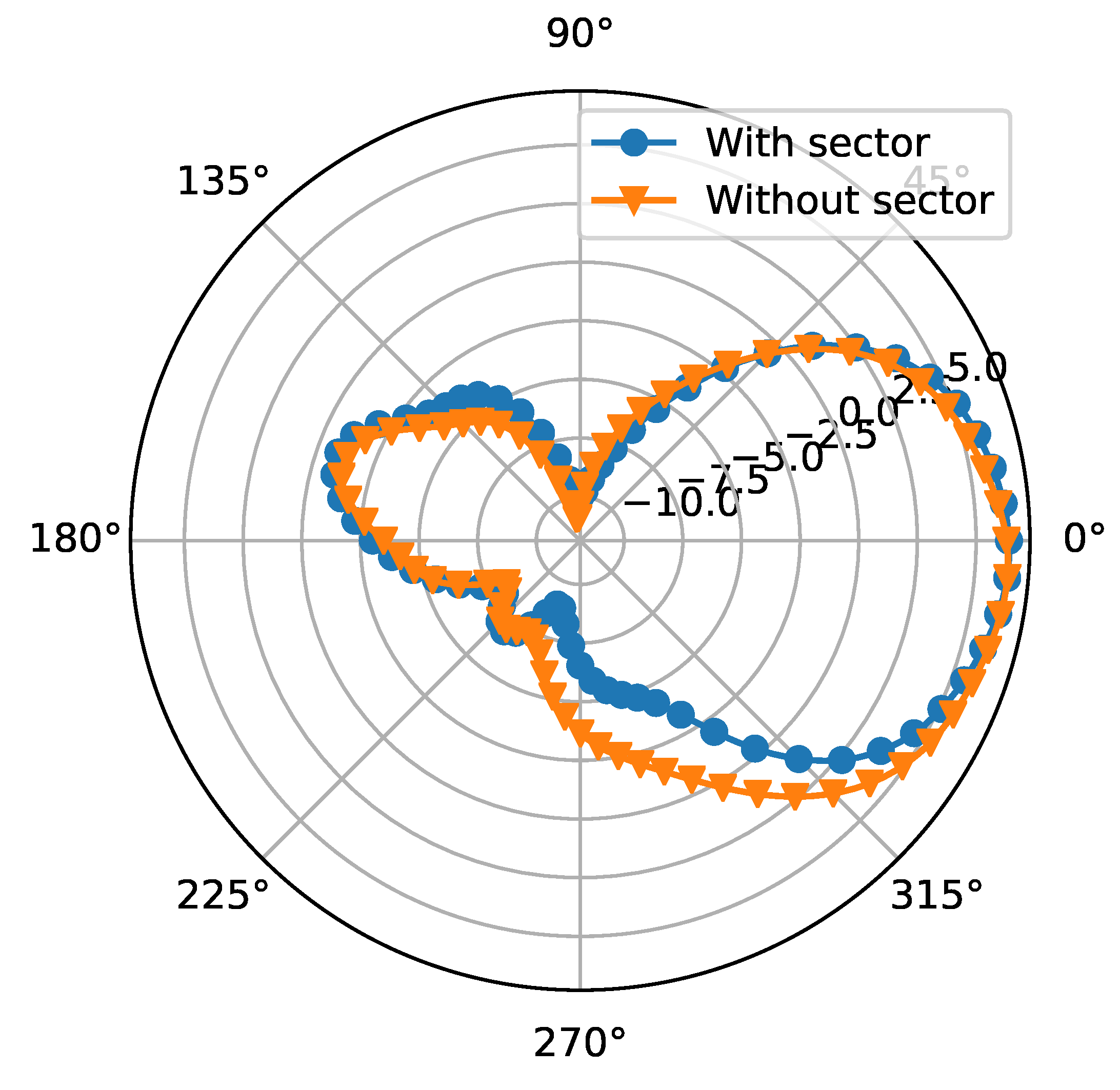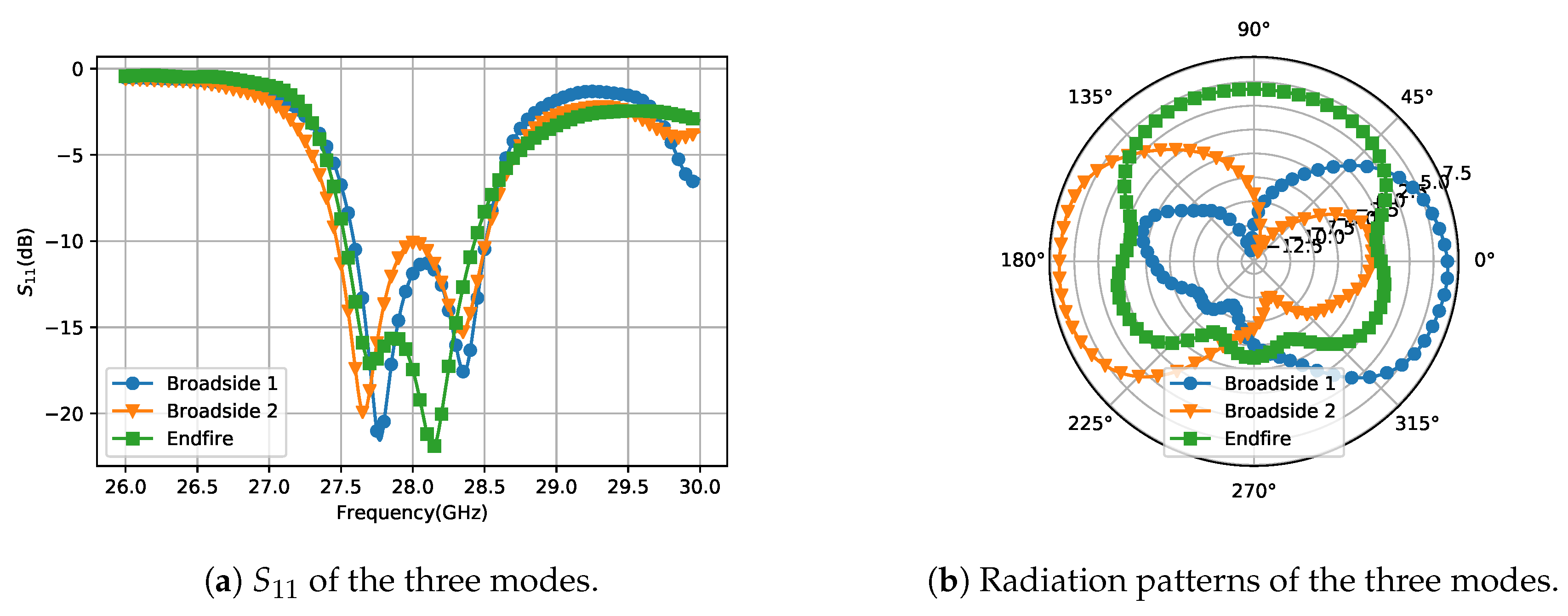3D Radiation Pattern Reconfigurable Phased Array for Transmission Angle Sensing in 5G Mobile Communication
Abstract
1. Introduction
2. Radiation Pattern Reconfigurable Antenna (RPRA)
2.1. Working Principle
2.2. Antenna Structure
- Patch 1 and Patch 2: The slots on SIW are able to radiate with broadside radiation patterns as well as patches. However, by introducing the patches as second radiators, the bandwidth is improved. Moreover, the impedance matching of the broadside modes is influenced by both the slots and the patches, which gives more freedom for the design. For example, more changes can be done on the patches instead of the slots. Since the slots are etched on the SIW, fewer changes lead to less influence on the other modes. It is an advantage in this RPRA design, which guarantees the design of the three modes independently to a certain degree. On the other hand, the additional patches do not increase the complicity of the whole antenna because multilayer structure is anyway needed for the DC feeding network.
- Dipole: The Dipole is fed by the SIW with a trapezoid shape transition. The arms are composed of two parallel strips for improving the bandwidth. The metallic via walls of the SIW is extended to the Dipole direction to improve isolation between the adjacent Dipoles for the array scenarios.
2.3. Beam Switching
2.4. The Simulation and Analysis
2.4.1. Design Procedure
- Step 1: Decide the SIW size according to the working frequency. The width of SIW should allow the lowest frequency to propagate and suppress the high order modes of the highest frequency.
- Step 2: Design the slots and dipole antennas separately at the working frequency band. For the slots, an inductive window is introduced to form a resonant cavity. The opening width of the window controls the energy coupling from the transmission line to the cavity.
- Step 3: Combine the slots and dipole within one SIW. The PIN diode effects should be considered in this step because the different loads lead to different input impedances. A compromise of impedance matching has to be made for all three modes.
- Step 4: Add the layer with patches. Increasing the thickness of the patch layers also increases the bandwidth of the broadside modes. The additional material has slight influence on the dipole. Adjust the size and position of the patches to get the best impedance matching for the broadside modes.
- Step 6: Add DC feeding lines and vias. Adjust the size and position of the sector patches to get the best RF blocking.
2.4.2. Parameter Analysis
2.4.3. Results
3. Design of Eight-Element Array
4. Conclusions
Author Contributions
Funding
Acknowledgments
Conflicts of Interest
Abbreviations
| RPRA | radiation pattern reconfigurable antenna |
| RPA | reconfigurable phased array |
| SIW | Substrate Integrated Waveguide |
| mm-wave | millimeter wave |
| 5G | fifth generation |
| MIMO | Multi-input Multi-output |
| IoT | Internet of Things |
Appendix A

References
- Rappaport, T.S.; Sun, S.; Mayzus, R.; Zhao, H.; Azar, Y.; Wang, K.; Wong, G.N.; Schulz, J.K.; Samimi, M.; Gutierrez, F. Millimeter Wave Mobile Communications for 5G Cellular: It Will Work! IEEE Access 2013, 1, 335–349. [Google Scholar] [CrossRef]
- Feng, W.; Li, Y.; Jin, D.; Su, L.; Chen, S. Millimetre-Wave Backhaul for 5G Networks: Challenges and Solutions. Sensors 2016, 16, 892. [Google Scholar] [CrossRef] [PubMed]
- Santos, J.; Wauters, T.; Volckaert, B.; De Turck, F. Fog Computing: Enabling the Management and Orchestration of Smart City Applications in 5G Networks. Entropy 2018, 20, 4. [Google Scholar] [CrossRef]
- Klaina, H.; Vazquez Alejos, A.; Aghzout, O.; Falcone, F. Narrowband Characterization of Near-Ground Radio Channel for Wireless Sensors Networks at 5G-IoT Bands. Sensors 2018, 18, 2428. [Google Scholar] [CrossRef] [PubMed]
- Agiwal, M.; Roy, A.; Saxena, N. Next Generation 5G Wireless Networks: A Comprehensive Survey. IEEE Commun. Surv. Tutor. 2016, 18, 1617–1655. [Google Scholar] [CrossRef]
- Andrews, J.G.; Bai, T.; Kulkarni, M.N.; Alkhateeb, A.; Gupta, A.K.; Heath, R.W. Modeling and Analyzing Millimeter Wave Cellular Systems. IEEE Trans. Commun. 2017, 65, 403–430. [Google Scholar] [CrossRef]
- Ramos, A.; Varum, T.; Matos, J.N. Compact Multilayer Yagi-Uda Based Antenna for IoT/5G Sensors. Sensors 2018, 18, 2914. [Google Scholar] [CrossRef] [PubMed]
- Helander, J.; Zhao, K.; Ying, Z.; Sjöberg, D. Performance Analysis of Millimeter-Wave Phased Array Antennas in Cellular Handsets. IEEE Antennas Wirel. Propag. Lett. 2016, 15, 504–507. [Google Scholar] [CrossRef]
- Wang, R.; Wang, B.Z.; Hu, C.; Ding, X. Wide-angle scanning planar array with quasi-hemispherical-pattern elements. Sci. Rep. 2017, 7, 2729. [Google Scholar] [CrossRef] [PubMed]
- Yang, Q.L.; Ban, Y.L.; Kang, K.; Sim, C.Y.D.; Wu, G. SIW Multibeam Array for 5G Mobile Devices. IEEE Access 2016, 4, 2788–2796. [Google Scholar] [CrossRef]
- Alreshaid, A.T.; Sharawi, M.S.; Podilchak, S.; Sarabandi, K. Compact Millimeter-Wave Switched-Beam Antenna Arrays for Short Range Communications. Microw. Opt. Technol. Lett. 2016, 58, 1917–1921. [Google Scholar] [CrossRef]
- Yu, B.; Yang, K.; Sim, C.Y.D.; Yang, G. A Novel 28 GHz Beam Steering Array for 5G Mobile Device with Metallic Casing Application. IEEE Trans. Antennas Propag. 2018, 66, 462–466. [Google Scholar] [CrossRef]
- Hsu, Y.W.; Huang, T.C.; Lin, H.S.; Lin, Y.C. Dual-Polarized Quasi Yagi-Uda Antennas with Endfire Radiation for Millimeter-Wave MIMO Terminals. IEEE Trans. Antennas Propag. 2017, 65, 6282–6289. [Google Scholar] [CrossRef]
- Xu, S.; Zhang, M.; Wen, H.; Wang, J. Deep-subwavelength Decoupling for MIMO Antennas in Mobile Handsets with Singular Medium. Sci. Rep. 2017, 7, 12162. [Google Scholar] [CrossRef] [PubMed]
- Xie, G.; Zhao, Z.; Yan, Y.; Li, L.; Ren, Y.; Ahmed, N.; Cao, Y.; Willner, A.J.; Bao, C.; Wang, Z.; et al. Demonstration of Tunable Steering and Multiplexing of Two 28 GHz Data Carrying Orbital Angular Momentum Beams Using Antenna Array. Sci. Rep. 2016, 6, 37078. [Google Scholar] [CrossRef] [PubMed]
- Ojaroudiparchin, N.; Shen, M.; Zhang, S.; Pedersen, G.F. A Switchable 3-D-Coverage-Phased Array Antenna Package for 5G Mobile Terminals. IEEE Antennas Wirel. Propag. Lett. 2016, 15, 1747–1750. [Google Scholar] [CrossRef]
- Zhang, S.; Chen, X.; Syrytsin, I.; Pedersen, G.F. A Planar Switchable 3-D-Coverage Phased Array Antenna and Its User Effects for 28-GHz Mobile Terminal Applications. IEEE Trans. Antennas Propag. 2017, 65, 6413–6421. [Google Scholar] [CrossRef]
- Stanley, M.; Huang, Y.; Wang, H.; Zhou, H.; Alieldin, A.; Joseph, S. A Capacitive Coupled Patch Antenna Array with High Gain and Wide Coverage for 5G Smartphone Applications. IEEE Access 2018, 6, 41942–41954. [Google Scholar] [CrossRef]
- Alam, M.S.; Abbosh, A.M. Wideband Pattern-Reconfigurable Antenna Using Pair of Radial Radiators on Truncated Ground with Switchable Director and Reflector. IEEE Antennas Wirel. Propag. Lett. 2017, 16, 24–28. [Google Scholar] [CrossRef]
- Wang, R.; Wang, B.; Gao, G.; Ding, X.; Wang, Z. Low-Profile Pattern-Reconfigurable Vertically Polarized Endfire Antenna With Magnetic-Current Radiators. IEEE Antennas Wirel. Propag. Lett. 2018, 17, 829–832. [Google Scholar] [CrossRef]
- Hossain, M.A.; Bahceci, I.; Cetiner, B.A. Parasitic Layer-Based Radiation Pattern Reconfigurable Antenna for 5G Communications. IEEE Trans. Antennas Propag. 2017, 65, 6444–6452. [Google Scholar] [CrossRef]
- Chen, S.; Qin, P.; Lin, W.; Guo, Y.J. Pattern-Reconfigurable Antenna with Five Switchable Beams in Elevation Plane. IEEE Antennas Wirel. Propag. Lett. 2018, 17, 454–457. [Google Scholar] [CrossRef]
- Row, J.; Tsai, C. Pattern Reconfigurable Antenna Array With Circular Polarization. IEEE Trans. Antennas Propag. 2016, 64, 1525–1530. [Google Scholar] [CrossRef]
- AlGaAs Beamlead PIN Diode. Available online: https://cdn.macom.com/datasheets/MA4AGBLP912.pdf (accessed on 26 November 2018).
- Luo, G.Q.; Hu, Z.F.; Dong, L.X.; Sun, L.L. Planar Slot Antenna Backed by Substrate Integrated Waveguide Cavity. IEEE Antennas Wirel. Propag. Lett. 2008, 7, 236–239. [Google Scholar] [CrossRef]
- Shin, G.S.; Kim, J.S.; Oh, H.M.; Choi, S.; Byeon, C.W.; Son, J.H.; Lee, J.H.; Kim, C.Y. Low Insertion Loss, Compact 4-bit Phase Shifter in 65 nm CMOS for 5G Applications. IEEE Microw. Wirel. Compon. Lett. 2016, 26, 37–39. [Google Scholar] [CrossRef]
- Tsai, J.H.; Lin, F.M.; Xiao, H. Low RMS phase error 28 GHz 5-bit switch type phase shifter for 5G applications. Electron. Lett. 2018, 54, 1184–1185. [Google Scholar] [CrossRef]













| 1.5 | 1.8 | 0.3 | 2.23 | 0.5 |
| 4.8 | 4.14 | 3.1 | 3.4 | 4 |
| Working Modes | , | , , , | , | |||
|---|---|---|---|---|---|---|
| Broadside 1 | on | off | off | on | off | on |
| Endfire | off | on | on | off | off | on |
| Broadside 2 | off | on | off | on | on | off |
© 2018 by the authors. Licensee MDPI, Basel, Switzerland. This article is an open access article distributed under the terms and conditions of the Creative Commons Attribution (CC BY) license (http://creativecommons.org/licenses/by/4.0/).
Share and Cite
Zhang, J.; Zhang, S.; Lin, X.; Fan, Y.; Pedersen, G.F. 3D Radiation Pattern Reconfigurable Phased Array for Transmission Angle Sensing in 5G Mobile Communication. Sensors 2018, 18, 4204. https://doi.org/10.3390/s18124204
Zhang J, Zhang S, Lin X, Fan Y, Pedersen GF. 3D Radiation Pattern Reconfigurable Phased Array for Transmission Angle Sensing in 5G Mobile Communication. Sensors. 2018; 18(12):4204. https://doi.org/10.3390/s18124204
Chicago/Turabian StyleZhang, Jin, Shuai Zhang, Xianqi Lin, Yong Fan, and Gert Frølund Pedersen. 2018. "3D Radiation Pattern Reconfigurable Phased Array for Transmission Angle Sensing in 5G Mobile Communication" Sensors 18, no. 12: 4204. https://doi.org/10.3390/s18124204
APA StyleZhang, J., Zhang, S., Lin, X., Fan, Y., & Pedersen, G. F. (2018). 3D Radiation Pattern Reconfigurable Phased Array for Transmission Angle Sensing in 5G Mobile Communication. Sensors, 18(12), 4204. https://doi.org/10.3390/s18124204






